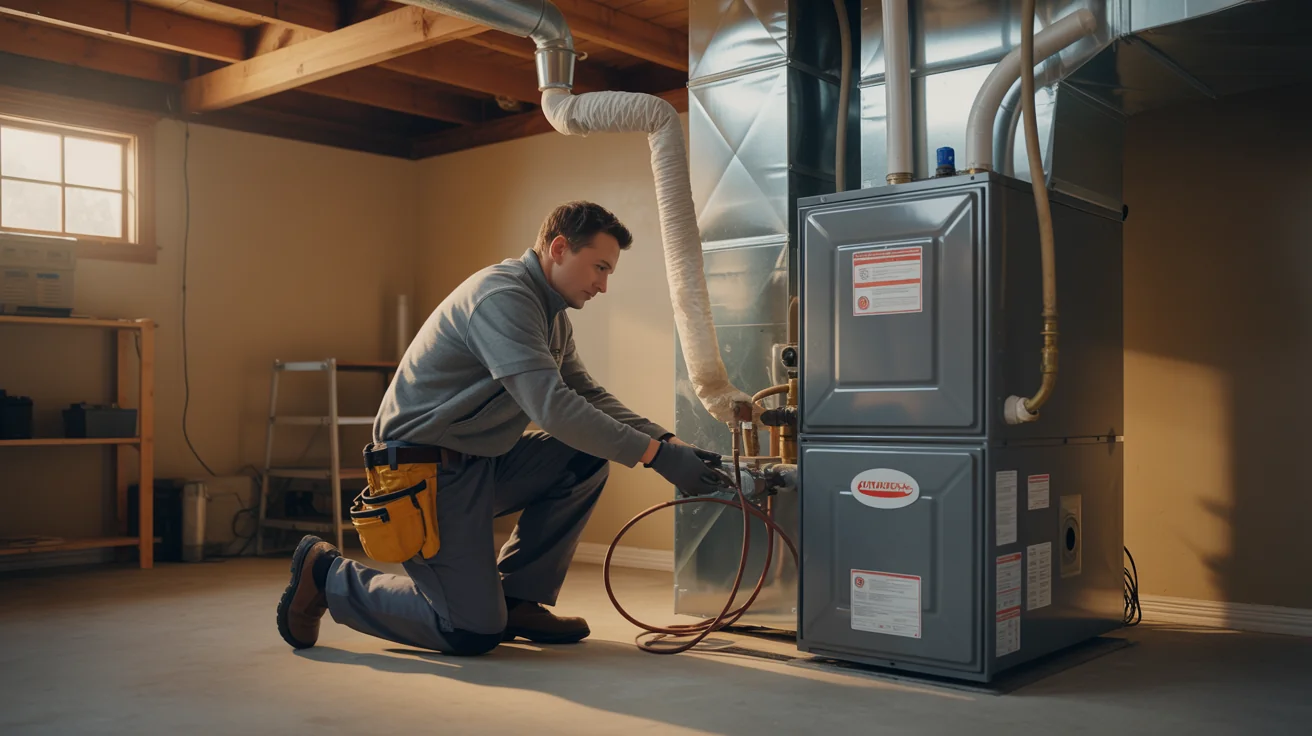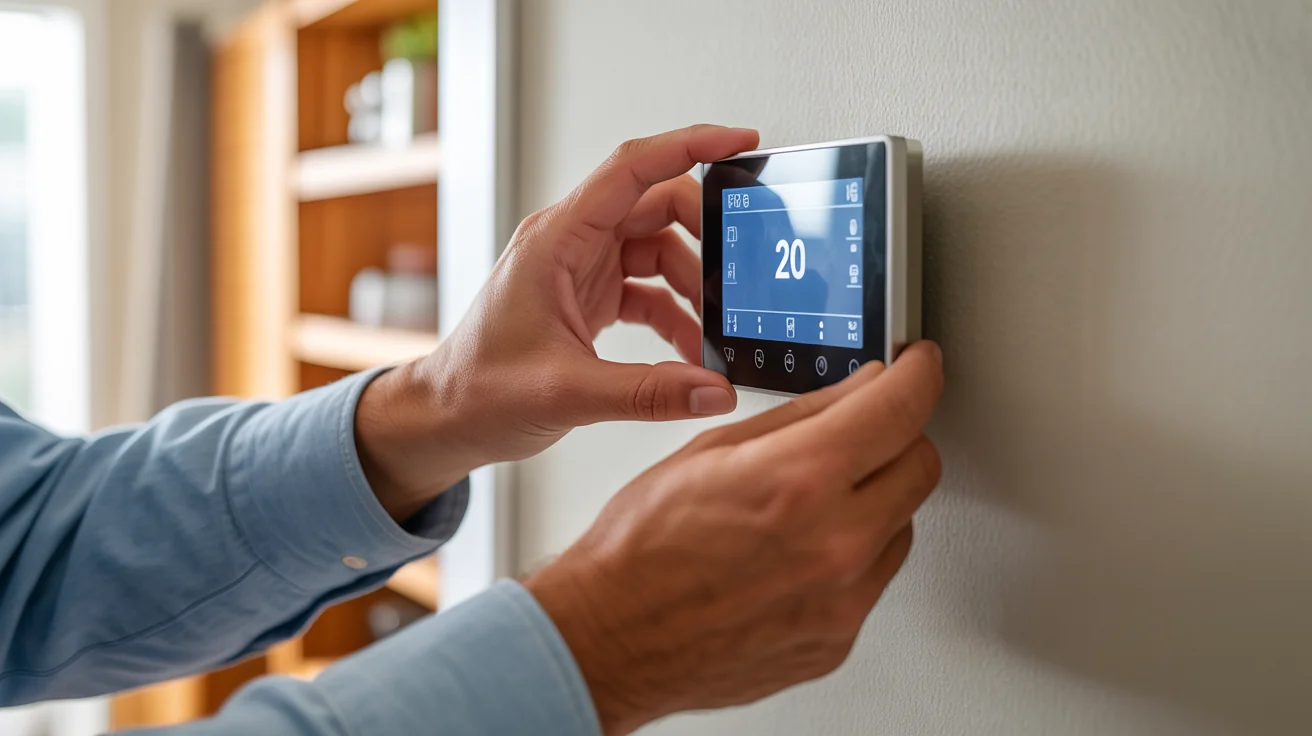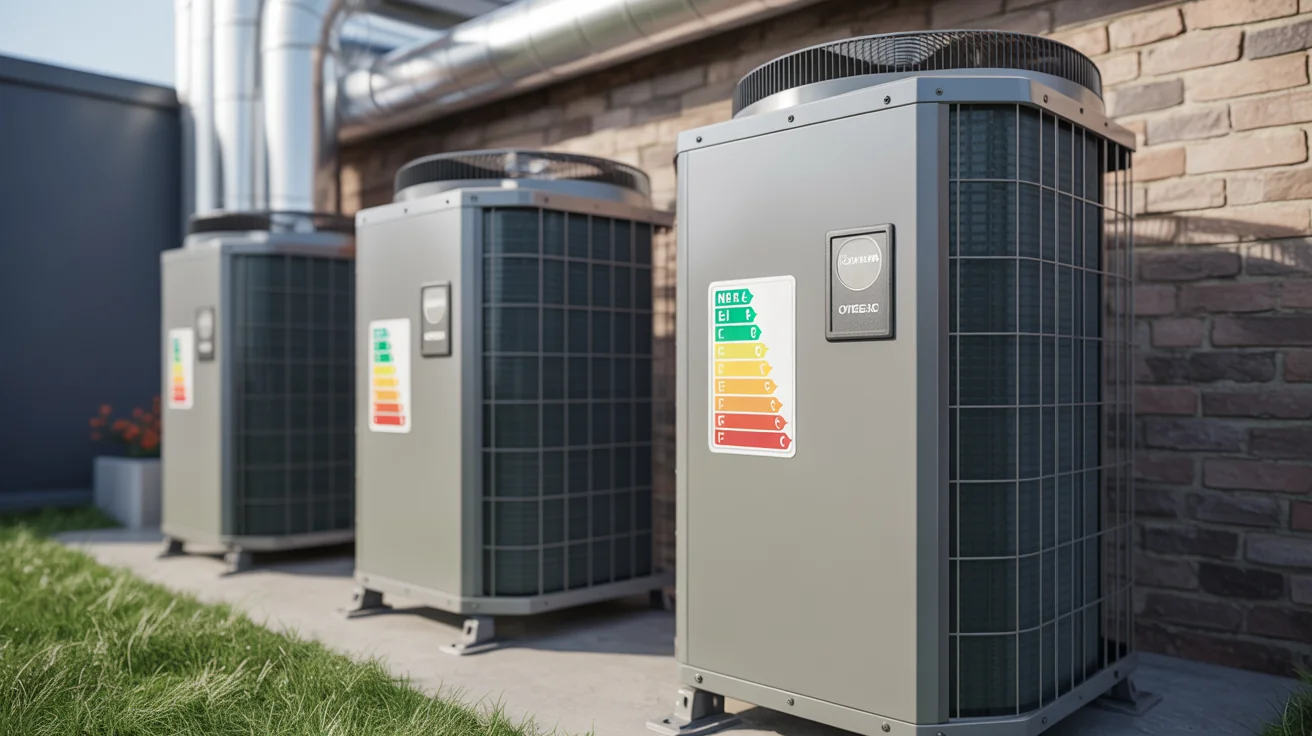Winter Furnace Safety Checklist Texas 2025: Essential Cold Weather Protection Guide
Comprehensive winter furnace safety checklist for Texas homes. Carbon monoxide prevention, emergency protocols, and cold weather safety measures.

- The Three Carbon Monoxide Calls That Still Wake Me Up
- Why Texas Winter Kills Differently
- Understanding Carbon Monoxide Dangers
- The Invisible Threat in Your Home
- Essential Winter Furnace Safety Equipment
- Carbon Monoxide Detection System
- Emergency Response Equipment
- Comprehensive Winter Safety Inspection
+ 17 more sections below...
- The Three Carbon Monoxide Calls That Still Wake Me Up
- Why Texas Winter Kills Differently
- Understanding Carbon Monoxide Dangers
- The Invisible Threat in Your Home
- Essential Winter Furnace Safety Equipment
- Carbon Monoxide Detection System
- Emergency Response Equipment
- Comprehensive Winter Safety Inspection
+ 17 more sections below...
The Three Carbon Monoxide Calls That Still Wake Me Up
In 15 years as an HVAC tech in North Texas, I’ve responded to three carbon monoxide emergencies that were minutes away from becoming obituaries.
The first was a family of five in McKinney. Kids complaining of headaches for a week. Parents thought it was the flu going around. When I got there with my CO detector, the readings made my blood run cold. The heat exchanger had a crack you could slide a business card through.
They were sleeping in a house slowly filling with poison gas.
Carbon monoxide from heating equipment kills 36 Texas families every winter. Thirty-six families who thought their furnaces were fine. Who didn’t know that hairline crack was leaking death into their air supply.
What haunts me isn’t just the tragedies - it’s how preventable they all are. Basic safety checks that take two hours can save lives. But most families skip them until it’s too late.
Why Texas Winter Kills Differently
Our unpredictable cold snaps create unique dangers that catch families completely off-guard:
Neglected systems sit idle for nine months, developing problems you’ll never notice until you need them most. Panic heating occurs when it drops to 20°F overnight, causing people to do desperate, dangerous things to stay warm. Ice storm blackouts cut power, and suddenly everyone’s running generators in garages and using camping stoves indoors. Thermal shock affects systems designed for gradual temperature changes that suddenly face 50-degree drops in 12 hours. Experience gap exists because unlike Minnesota families, we don’t live with heating systems and don’t recognize the warning signs.
The Harsh Reality: Texas families are three times more likely to have heating-related emergencies than families in Minnesota. Why? Because Minnesota families know their furnaces intimately. They use them eight months a year. We fire ours up twice a winter and expect miracles.
Understanding Carbon Monoxide Dangers
The Invisible Threat in Your Home
Carbon monoxide (CO) is an odorless, colorless gas produced by incomplete combustion in gas furnaces, water heaters, fireplaces, and other fuel-burning appliances.
How CO Forms in Heating Systems: Cracked heat exchangers allow combustion gases to mix with breathable air. Blocked venting causes exhaust gases to back up into living spaces. Poor combustion air supply creates incomplete burning and CO production. Damaged flue pipes leak combustion gases before they exit the home. Negative pressure pulls exhaust gases back into the house.
CO Poisoning Symptoms by Exposure Level:
Low-Level Exposure (1-70 PPM):
- Mild headaches and fatigue
- Flu-like symptoms without fever
- Difficulty concentrating
- Shortness of breath during mild exertion
Moderate Exposure (70-150 PPM):
- Severe headaches and dizziness
- Confusion and disorientation
- Nausea and vomiting
- Rapid heartbeat and chest pain
High-Level Exposure (150+ PPM):
- Loss of consciousness
- Convulsions and seizures
- Cardiorespiratory failure
- Death within hours
Life-Saving Recognition: If multiple family members develop flu-like symptoms simultaneously, especially during heating season, evacuate immediately and call 911.
Essential Winter Furnace Safety Equipment
Carbon Monoxide Detection System
Detector Placement Requirements: Install one detector per floor including basement and attic levels to ensure complete coverage throughout your home. Place detectors within 10 feet of each bedroom door to provide early warning while family members sleep. Position detectors at least 15 feet away from fuel-burning appliances to avoid false alarms from normal operation. Avoid placement in kitchens, garages, or areas with high humidity where false alarms frequently occur.
Detector Types and Features:
Battery-Powered Detectors ($25-$50):
- Easy installation, no wiring required
- Must check and replace batteries every 6 months
- Good for initial protection and rental properties
- Replace entire unit every 7 years
Hardwired Detectors ($50-$100):
Hardwired detectors connect to your home electrical system for reliable power and include battery backup for power outages. They can be interconnected for whole-house alerts that ensure everyone hears warnings regardless of location. Professional installation is recommended to ensure proper wiring and compliance with local electrical codes.
Smart CO Detectors ($80-$200):
Smart CO detectors send alerts to your smartphone when you’re away from home, ensuring immediate notification of dangerous conditions. They provide real-time CO level readings that help you monitor air quality and detect gradual increases before they become dangerous. Integration with home security systems provides comprehensive home monitoring and professional monitoring response. Self-testing capabilities with status reports ensure your detectors are always functioning properly.
Emergency Response Equipment
Emergency Communication:
Maintain an updated contact list for emergency services including local fire, police, and medical response teams. Keep Jupitair’s 24/7 emergency line readily available: (940) 390-5676 for immediate HVAC emergency response. Include neighbor contacts for emergency assistance when family members may not be able to respond. Store medical emergency numbers for family members who may require special assistance during emergencies.
Safety Equipment Checklist:
- Working flashlights with fresh batteries
- Battery-powered radio for weather updates
- First aid kit with CO poisoning response guide
- Emergency blankets and warm clothing accessible
- Portable phone chargers or battery packs
Comprehensive Winter Safety Inspection
Phase 1: Visual Safety Assessment
Step 1: Furnace Area Inspection (20 minutes)
Clearance and Ventilation Check:
- Maintain 3-foot clearance around furnace on all sides
- Remove all combustible materials (paper, paint, cleaning supplies)
- Check for adequate combustion air supply (vents unblocked)
- Verify proper lighting and access for emergency repairs
Visual Component Assessment:
- Inspect heat exchanger surface for cracks or rust
- Check flue pipe connections for gaps or corrosion
- Look for soot deposits around furnace or venting
- Document any unusual discoloration or damage with photos
Gas Line and Connection Safety:
- Visual inspection of gas connections for corrosion
- Check for proper support and protection of gas lines
- Smell test for gas odors (any odor requires immediate evacuation)
- Verify gas shut-off valve location and accessibility
Step 2: Venting System Inspection (30 minutes)
Internal Venting Assessment:
- Check all accessible flue pipe sections for damage
- Verify proper slope and support of horizontal sections
- Look for rust, corrosion, or separation at joints
- Inspect flue pipe penetrations through walls or roof
External Vent Inspection:
- Check vent termination for blockages or damage
- Verify adequate clearance from windows and air intakes
- Look for signs of backdrafting (soot around vent cap)
- Remove any bird nests, debris, or ice accumulation
Draft and Airflow Testing:
- Turn on furnace and check for proper draft
- Hold tissue paper near draft hood to test airflow direction
- Look for any signs of backdrafting or spillage Warning: any backdrafting requires immediate professional service.
Phase 2: Operational Safety Testing
Step 3: CO Detector Testing and Setup (15 minutes)
Detector Function Test:
- Test each detector using built-in test button
- Replace batteries in all battery-operated units
- Verify proper alarm sound (85+ decibels)
- Check expiration dates (replace units over 7 years old)
Baseline CO Measurement:
- Use digital CO meter if available (optional but recommended)
- Record normal background levels (should be 0-9 PPM)
- Test near furnace during operation (should remain under 35 PPM)
- Document readings for comparison over winter season
Step 4: Safe Operation Verification (45 minutes)
Controlled Startup Test:
- Ensure all family members are informed of test
- Start furnace and monitor for first 15 minutes
- Listen for proper ignition sequence and smooth operation
- Watch for any unusual sounds, odors, or visual changes
Performance Monitoring:
- Check supply air temperature (should reach 90-120°F)
- Verify even heating throughout home
- Monitor CO detectors during first hour of operation
- Document any performance concerns for professional evaluation
Phase 3: Emergency Preparedness
Step 5: Family Safety Protocol Setup (30 minutes)
Emergency Evacuation Plan:
- Identify fastest exit routes from each room
- Designate outdoor meeting point away from house
- Practice evacuation with all family members
- Ensure everyone knows how to shut off gas at meter
Emergency Contact System:
- Program emergency numbers into all phones
- Post emergency contacts near telephones
- Ensure babysitters and visitors know protocols
- Update emergency contacts with new addresses/numbers
Winter-Specific Preparations:
- Stock extra blankets accessible without heating
- Prepare battery-powered heating options (safe types only)
- Plan alternative shelter locations (friends, family, warming centers)
- Keep vehicle winterized for emergency transportation
Dangerous Heating Methods to Avoid
Never Use These for Emergency Heating
Extremely Dangerous (Can Kill in Minutes):
Outdoor grills or camping equipment used indoors can produce lethal CO levels within minutes in enclosed spaces. Vehicle engines running in garages, even with doors open, create dangerous CO concentrations that can be fatal. Unvented kerosene or propane heaters burn oxygen and produce CO in enclosed spaces without safe ventilation. Charcoal briquettes or wood burning in fireplaces without proper venting can create deadly CO levels throughout your home.
Highly Dangerous (Fire and CO Risk):
Kitchen ovens or stovetops used for space heating create both CO risks and fire hazards while damaging appliances not designed for continuous operation. Multiple space heaters on the same electrical circuit can overload wiring and cause electrical fires. Extension cords with space heaters create fire risks from overheating and should never be used together. Space heaters placed near curtains, furniture, or bedding create immediate fire hazards that can ignite surrounding materials.
Moderately Dangerous (Requires Extreme Caution):
- Fireplaces without annual chimney inspection
- Wood-burning stoves without proper ventilation
- Generator operation closer than 20 feet from home
- Space heaters without tip-over and overheat protection
Safe Emergency Heating Options
Approved Electric Space Heaters:
- UL-listed units with tip-over shutoff
- Overheat protection and thermostat control
- Proper wattage for electrical circuit (1,500W maximum per outlet)
- 3-foot clearance from all combustible materials
Battery-Powered Heating:
- Electric blankets with battery packs
- Personal heating pads designed for extended use
- Body warmers and heat packs (follow manufacturer instructions)
- Layered clothing and insulated sleeping bags
Professional Winter Safety Services
When to Schedule Emergency Inspection
Immediate Professional Service Required:
- Any visible cracks in heat exchanger
- Gas odors near heating equipment
- Unusual sounds during furnace operation
- Persistent headaches or flu symptoms in multiple family members
Recommended Professional Services:
Emergency Safety Inspection ($149):
- Complete combustion safety testing
- CO emission testing at furnace and throughout home
- Heat exchanger integrity assessment
- Venting system inspection and testing
Comprehensive Winter Safety Check ($225-$325):
- Full safety inspection with written report
- CO detector installation and testing
- Emergency response plan development
- Winter maintenance and optimization
Carbon Monoxide Testing Service ($75-$125):
- Professional-grade CO testing throughout home
- Baseline measurement establishment
- Problem source identification if CO detected
- Written safety certification for insurance/records
Jupitair Emergency Winter Safety Response
24/7 Emergency Service Features:
- 30-minute response time for CO emergencies
- Professional-grade CO testing equipment
- Complete safety system evaluation
- Emergency repair capabilities for safe operation
Emergency Safety Protocol:
- First responder coordination if needed
- Temporary heating solutions for displaced families
- Complete system safety verification before restart
- Follow-up monitoring to make sure continued safety
Winter Storm Preparation and Response
Pre-Storm Safety Checklist
48 Hours Before Storm:
- Test all CO detectors and replace batteries
- Check furnace operation and note any issues
- Stock emergency supplies (blankets, flashlights, batteries)
- Charge all electronic devices and battery packs
24 Hours Before Storm:
- Clear area around outdoor furnace vents
- Insulate exposed pipes to prevent freezing
- Review evacuation plan with family
- Contact vulnerable neighbors to check on preparedness
During Winter Weather Emergency
Power Outage Protocols:
- Never operate generators inside home or garage
- Maintain 20-foot minimum distance from house
- Keep generator exhaust directed away from windows/doors
- Monitor CO detectors (battery-powered) continuously
Heating System Failure Response:
- Assessment: Check thermostat, circuit breakers, and air filter
- Documentation: Note any unusual sounds, smells, or visible problems
- Family Safety: Implement safe temporary heating measures only
- Professional Help: Call Jupitair emergency line: (940) 390-5676
- Monitoring: Watch family members for CO poisoning symptoms
Recognizing and Responding to CO Emergencies
Emergency Response Protocol
If CO Detector Sounds:
- Evacuate immediately - Do not investigate source
- Call 911 from safe location outside home
- Account for all family members and pets
- Do not re-enter until cleared by fire department
- Call Jupitair for emergency system inspection before restart
If CO Poisoning Suspected:
- Get fresh air immediately - Move to outdoor location
- Call 911 - Request ambulance for possible CO poisoning
- Stay outside - Do not return to investigate until cleared
- Seek medical attention - Even mild symptoms require evaluation
- Have heating system inspected before operating again
Medical Emergency Response
CO Poisoning Treatment:
- High-flow oxygen therapy administered by paramedics
- Hospital evaluation even for mild exposure cases
- Potential hyperbaric oxygen therapy for severe poisoning
- Follow-up care for neurological effects
Recovery and Prevention:
- Professional HVAC safety inspection required before system restart
- CO detector system upgrade with interconnected units
- Annual professional safety inspections going forward
- Family education on prevention and early recognition
Long-Term Safety Maintenance
Annual Safety Requirements
Professional Annual Inspections:
- Heat exchanger integrity assessment
- Combustion efficiency and safety testing
- Venting system inspection and cleaning
- CO emission testing throughout heating season
Homeowner Monthly Tasks:
- CO detector testing and battery replacement
- Visual furnace inspection for obvious problems
- Air filter replacement for proper combustion air
- Emergency supply kit maintenance and updates
Investment in Family Safety
Essential Safety Upgrades:
CO Detection System ($200-$800):
- Interconnected hardwired detectors throughout home
- Smart monitoring with smartphone alerts
- Professional installation and annual testing
- 10-year warranty and replacement program
Professional Safety Monitoring ($150-$300/year):
- Annual combustion safety testing
- Priority emergency response service
- Safety equipment maintenance and updates
- Family safety education and protocol updates
Frequently Asked Questions
Q: How often should I test my carbon monoxide detectors? A: Test monthly using the test button, replace batteries every 6 months, and replace the entire unit every 7 years. Smart detectors can perform automatic self-tests.
Q: What should I do if I smell gas near my furnace? A: Evacuate immediately, don’t use electrical switches or phones inside, call your gas company emergency line from outside, and don’t re-enter until cleared by professionals.
Q: Can I use my fireplace if my furnace isn’t working? A: Only if the chimney has been professionally inspected within the past year and you have working CO detectors. Never burn anything other than seasoned hardwood.
Q: How do I know if my heat exchanger is cracked? A: Professional testing is required. Visual signs include rust flakes, soot deposits, or flame color changes, but microscopic cracks are only detectable with specialized equipment.
Q: Is it safe to use space heaters for extended periods? A: Only UL-listed electric units with safety shutoffs, proper electrical circuits, and 3-foot clearance. Never use fuel-burning space heaters indoors.
Q: What temperature should I maintain during a power outage? A: Focus on family safety, not comfort. Layer clothing and blankets, stay in one room together, and use only approved battery-powered heating methods.
Protect Your Family This Winter
Don’t gamble with your family’s safety during North Texas winter weather. Following this complete safety checklist can prevent tragic accidents while ensuring reliable heating performance when you need it most.
Ready for winter safety? Call (940) 390-5676 to schedule an emergency safety inspection from experienced North Texas heating specialists. Our emergency service is available 24/7 with CO detection and furnace safety specialists ready to respond immediately. We provide professional safety testing with comprehensive home safety evaluation to protect your family. We serve all North Texas communities including Frisco, Plano, McKinney, Allen, The Colony, Little Elm, and surrounding areas.
Your family’s safety is worth more than any heating bill. Professional safety verification make sures peace of mind throughout North Texas winter weather.
Last updated: August 2025 | Based on Texas Department of Health winter safety data | Emergency response protocols tested and proven
Jupitair HVAC: Licensed & Insured, and your North Texas winter safety specialists. Protecting families with professional heating service since 2008.
Need Professional HVAC Service?
Our certified technicians are ready to help with any HVAC needs in North Texas



